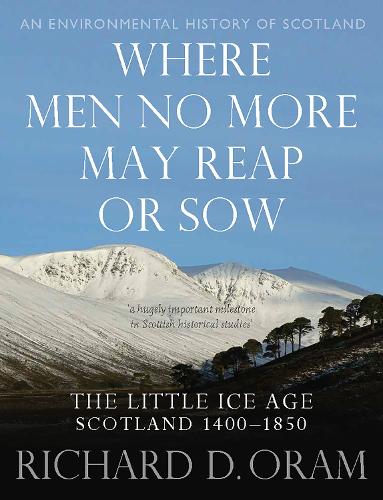
Where Men No More May Reap or Sow: The Little Ice Age: Scotland 14001850
(Hardback)
Publishing Details
Where Men No More May Reap or Sow: The Little Ice Age: Scotland 14001850
By (Author) Richard D. Oram
John Donald Publishers Ltd
John Donald Publishers Ltd
13th September 2024
United Kingdom
Classifications
Tertiary Education
Non Fiction
Environmental archaeology
Restoration ecology / rewilding
Ecological science, the Biosphere
Conservation of the environment
941.103
Physical Properties
Hardback
432
Width 189mm, Height 246mm, Spine 28mm
1514g
Description
Drawing together the evidence of archaeology, palaeoecology, climate history and the historical record, this first environmental history of Scotland explores the interaction of human populations with the land, waters, forests and wildlife.
This volume spans 450 years that saw profound transformation in Scotland's environment. It begins in the fifteenth century, when the 'Golden Age' of the early 1200s was but a fading folk memory in a land gripped by the gathering grimness of a 'little ice age'. Colder, wetter, stormier weather became the new normal, interspersed with brief episodes of warmer but still moist conditions, all of which brought huge challenges to a society on the knife-edge of subsistence. Viewing the religious and political upheavals of the sixteenth and seventeenth centuries against the cycles of disease and dearth that were ever-present into the later 1700s, the book explores the slow adoption and application of the ideas of 'Improvement' and the radical disruption of Scotland's environment that ensued. Reformation, revolution and rebellion were the background noise to efforts to subsist and succeed through a hostile age, in which Scotland's environment was an adversary to be tamed, mastered and made 'polite'. As the last, bitter decades of the 'little ice age' were ground out in foreign wars, forced clearances and potato famines, Scotland prepared itself to embrace the Industrial Age.
Reviews
'Oram has given us a new perspective not just on Scotland's environmental history, but on Scottish history overall. By utilising and combining innovative methodologies and a staggering breadth of sources, he presents us with a magisterial and original account of Scotland and the Scots, as well as vital lessons for our society today and into the future'
-- Professor Annie Tindley, Newcaste University'Brings a much-neglected dimension to our understanding of the past, arguing that climactic and environmental change were the backdrop to social, political, religious and cultural change'
-- Professor Alison Cathcart, University of Stirling'[This series] traces and explains the vast panorama of Scottish experience . . . through successive generations of crises and opportunities, both natural and man-made . . . Its scope and its impact are breathtaking, ambitious and far-reaching'
-- Dr Michael Penman, University of StirlingAuthor Bio
Richard D. Oram gained an MA (Hons) in Medieval History with Archaeology and a PhD in Medieval History, both from the University of St Andrews. He is currently Professor of Medieval and Environmental History at the University of Stirling. A former Director of the Centre for Environmental History and Policy and member of the Historic Environment Advisory Council for Scotland, he is now a Trustee of the National Museums of Scotland.
